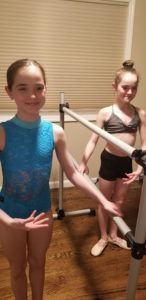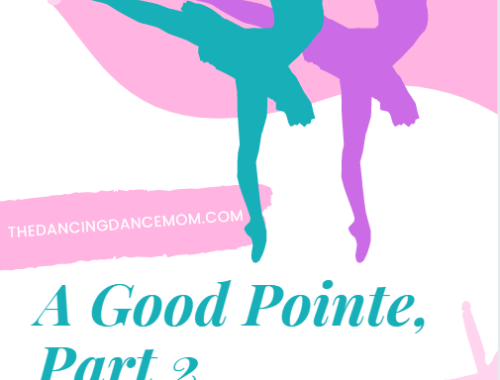
Setting Up a Dance Space at Home – Part 3 – Meet Me at the Barre

When prompted, I could wax poetic about how ballet is the foundation for all dance, how important having proper ballet training is, how your dancers will become better if they invest enough time and effort into developing their ballet technique, and so on. Chances are, though, you have already heard that. The point is this: ballet classes frequently utilize a barre, making it a very useful tool for dancers to have in their at-home dance spaces. Barres are not just for ballerinas and ballerinos anymore – the barre fitness movement is bringing the benefits of this type of workout to the general public, so other family members can find a way to incorporate it into their daily (or weekly, don’t judge) activity. I even use it during my online Barre Blend workout!
If you do not already have a barre and have no plans to purchase one in the near future, your dancer could make do with a chair that has some sort of back. Avoid ones that swivel, unless you’re okay with your kid risking a nasty wipeout (if that sounds tempting, remember that your children will be choosing your nursing home one day). Before you settle on one, your dancer should give it a test drive to see that it can work with his or her height. You might have to experiment with every chair you own before you find a good fit. Something else to consider is how narrow the back is; your dancer’s ankles are going to be resting on it for some time, so anything too narrow might cause a degree of pain when pressing into the flesh, tendons, and bone. Try slicing a pool noodle horizontally to fit over the back for added comfort.
If you’re planning to purchase an actual barre, you’ve got a few things to decide first.
Portable (or Freestanding) Barres
Most families opt for portable barres when creating an at-home dance space. They’re usually made of lightweight, sturdy material, and are fairly easy to assemble and break down. Before you purchase one, think about whether you’ll need a single or double bar. Single bars are usually cheaper, but double bars offer more versatility. If you have more than one dancing darling at home, having a barre that provides two different heights simultaneously is the way to go (think of sisters that are relatively close in age, but in the same class, like we have in our group). Make sure the barre is adjustable so your dancer can use it as she or he grows, and decide how long you want the barre to be (measure twice, purchase once). Having solid bases and non-slip feet are essential as well. Another decision to make is the composition is the horizontal bar; it’s usually aluminum or wood, with higher-end models offering ash (be prepared to open your wallet a bit wider for the ash). We have this Vita-Vibe double barre, which fits our needs perfectly.
If a new barre is outside of your budget, try scouring online sales sites. I’ve scored some great finds in local Facebook sales groups, and I see ads for these portable barres fairly frequently. For something like this, I wouldn’t worry about buying it secondhand; kids of all ages give up dance for a variety of reasons, so it’s one of the first things parents will pitch to free up some space. Just because they’re getting rid of it doesn’t mean it’s defective.
Fixed (or Mounted) Barres
Wall – If you have a dedicated space and are willing to drill some holes into your drywall, a wall-mounted barre might be the way to go. Again, you’ll need to decide whether a single or double horizontal bar meets your dancer’s needs best when selecting one. While most of the options are a fixed height, some manufacturers do offer a hinged model for their single bars that allows for two or three different heights. Measure your wall space to determine how long you want the bar to be, as they come in a wide range of lengths. Brackets have come a long way – there is a vast variety of decorative bracket sets available now, from elegant black ones to whimsical butterfly pieces.
Floor – Let’s say that the only wall you can install a barre in is mirrored or has windows, or there are some other factors that prevent you from mounting it into the wall. A floor-mounted barre might be the solution to that problem. They come with either single or double horizontal bars, offer varying lengths, and can provide either fixed or adjustable heights. There are some serious considerations you need to ponder before choosing this option, though. First, it is recommended that a professional contractor (someone that knows what they are doing; in other words, not me) drill the bases into the sub-floor. So the sheer logistics of this process are a major turn-off for me, personally, and I barely scratched the surface of what a project like this would actually require. Next, these are pricier than the wall-mounted options. My advice would be to carefully read all of the specifications, customer reviews and feedback, and manufacturer’s recommendations before making a final decision on this.
Barre None
If you have dance parent friends that have a barre at home, pick their brains for feedback on what they like and dislike about what they’ve got. Your studio director, dance teachers, and online dance parent chat groups can also provide some recommendations.
All in all, a ballet barre is a worthwhile investment and will help your dancers get the most out of their virtual dance instruction, so take the time to do the homework before picking one.
This post contains affiliate links. We may earn compensation when you click on the links at no additional cost to you.
Work hard, have fun! – Danielle
If you already have a barre at home, how much has your dancer used it? Post a comment below!
For an even more complete dance space, consider setting up a mirror! The benefits are explored in Mirror, Mirror.
You May Also Like

A Good Pointe, Part 2
September 30, 2020
Emotional Roller Coaster
August 10, 2020


